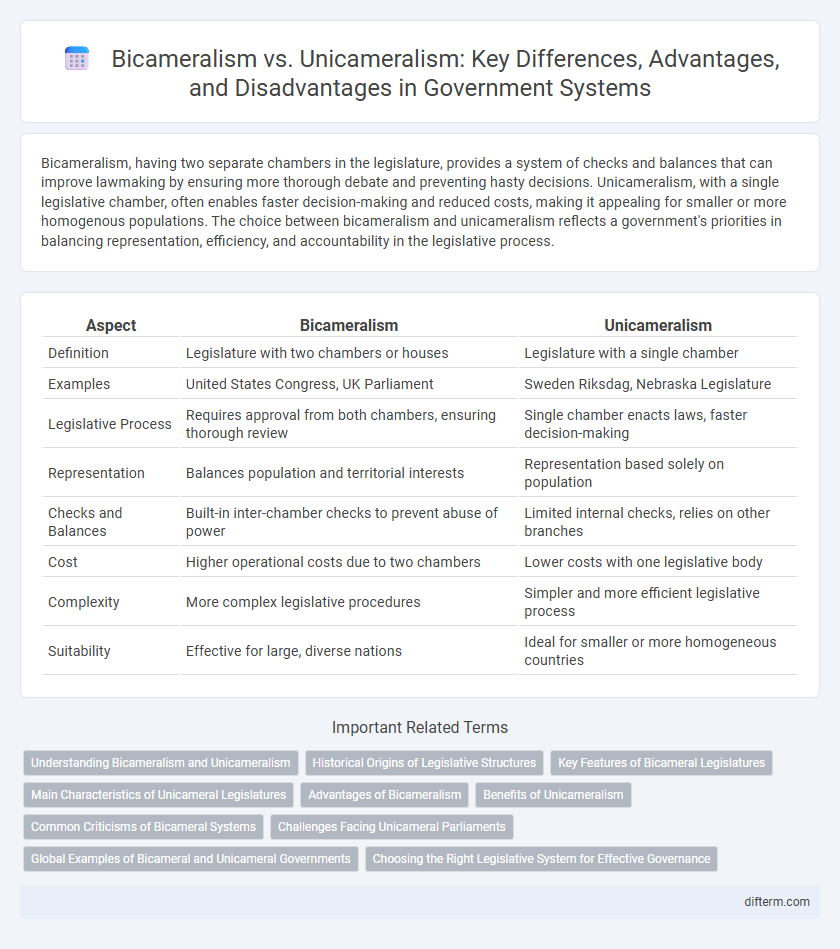Bicameralism, having two separate chambers in the legislature, provides a system of checks and balances that can improve lawmaking by ensuring more thorough debate and preventing hasty decisions. Unicameralism, with a single legislative chamber, often enables faster decision-making and reduced costs, making it appealing for smaller or more homogenous populations. The choice between bicameralism and unicameralism reflects a government's priorities in balancing representation, efficiency, and accountability in the legislative process.
Table of Comparison
| Aspect | Bicameralism | Unicameralism |
|---|---|---|
| Definition | Legislature with two chambers or houses | Legislature with a single chamber |
| Examples | United States Congress, UK Parliament | Sweden Riksdag, Nebraska Legislature |
| Legislative Process | Requires approval from both chambers, ensuring thorough review | Single chamber enacts laws, faster decision-making |
| Representation | Balances population and territorial interests | Representation based solely on population |
| Checks and Balances | Built-in inter-chamber checks to prevent abuse of power | Limited internal checks, relies on other branches |
| Cost | Higher operational costs due to two chambers | Lower costs with one legislative body |
| Complexity | More complex legislative procedures | Simpler and more efficient legislative process |
| Suitability | Effective for large, diverse nations | Ideal for smaller or more homogeneous countries |
Understanding Bicameralism and Unicameralism
Bicameralism features two legislative chambers, often designed to balance representation by region and population, enhancing checks and balances within government. Unicameralism operates with a single legislative body, promoting legislative efficiency and streamlined decision-making. The choice between bicameralism and unicameralism affects lawmaking processes, political accountability, and policy outcomes.
Historical Origins of Legislative Structures
Bicameralism historically emerged in medieval Europe, with roots tracing back to the English Parliament's division into the House of Commons and the House of Lords, aimed at balancing representation between nobility and commoners. Unicameralism, often associated with early American states like Pennsylvania and modern Scandinavian countries, evolved to simplify legislative processes and increase efficiency by consolidating lawmaking into a single chamber. These legislative structures reflect different approaches to governance, influenced by cultural, social, and political contexts shaping the evolution of representative institutions.
Key Features of Bicameral Legislatures
Bicameral legislatures consist of two distinct chambers, typically an upper house and a lower house, each with specific powers and responsibilities. This system enhances checks and balances by allowing for more thorough scrutiny of legislation and representing different interests, such as regional versus population-based representation. Countries like the United States and the United Kingdom exemplify bicameralism, where the Senate and House of Representatives or the House of Lords and House of Commons play complementary roles in the lawmaking process.
Main Characteristics of Unicameral Legislatures
Unicameral legislatures consist of a single parliamentary chamber, streamlining the legislative process by eliminating the need for inter-house coordination. This structure promotes efficiency in decision-making and reduces bureaucratic delays, often resulting in faster law enactment. Unicameral systems are typically found in smaller or more homogeneous countries where simplicity and cost-effectiveness are prioritized over extensive checks and balances.
Advantages of Bicameralism
Bicameralism offers enhanced checks and balances by dividing legislative power between two chambers, reducing the risk of hasty or unrepresentative lawmaking. It allows for more thorough review and debate of legislation, promoting greater scrutiny and refinement of laws. The presence of two chambers ensures diverse representation, often balancing regional or demographic interests effectively within the government structure.
Benefits of Unicameralism
Unicameralism streamlines legislative processes by reducing redundancy and accelerating decision-making, leading to more efficient governance. This system lowers administrative costs due to having a single legislative chamber, simplifying budgeting and resource allocation. Unicameral legislatures also enhance accountability by concentrating responsibility within one body, making it easier for citizens to monitor and evaluate government actions.
Common Criticisms of Bicameral Systems
Bicameral systems often face criticism for creating legislative gridlock due to the need for consensus between two chambers, which can delay lawmaking and reduce government efficiency. The potential for unequal representation arises when one house represents regions or states disproportionately compared to population, leading to questions of democratic fairness. Critics also highlight increased governmental costs and complexity as bicameral legislatures require more resources and procedural coordination than unicameral systems.
Challenges Facing Unicameral Parliaments
Unicameral parliaments often face challenges such as insufficient representation, leading to the marginalization of minority groups and regional interests. The absence of a second chamber can reduce oversight and scrutiny of legislation, increasing the risk of hasty or poorly considered laws. Furthermore, unicameral systems might struggle with balancing efficiency and democratic accountability, potentially concentrating power within a single legislative body.
Global Examples of Bicameral and Unicameral Governments
Bicameral governments, featuring two legislative chambers, are exemplified by countries such as the United States with its Senate and House of Representatives, and India with its Rajya Sabha and Lok Sabha, enabling a system of checks and balances in lawmaking. Unicameral governments, where a single legislative body holds authority, are observed in nations like Sweden and New Zealand, streamlining legislative processes and reducing governmental complexity. The choice between bicameralism and unicameralism often reflects historical, political, and administrative factors influencing each nation's governance structure.
Choosing the Right Legislative System for Effective Governance
Bicameralism, featuring two legislative chambers, promotes checks and balances by allowing detailed review and diverse representation, which enhances policy stability and minority protection. Unicameralism offers streamlined decision-making and greater legislative efficiency, reducing costs and speeding up law enactment, suitable for smaller or more homogenous populations. Selecting the right system depends on a country's size, diversity, and governance goals to balance effective oversight and responsiveness.
Bicameralism vs Unicameralism Infographic

 difterm.com
difterm.com